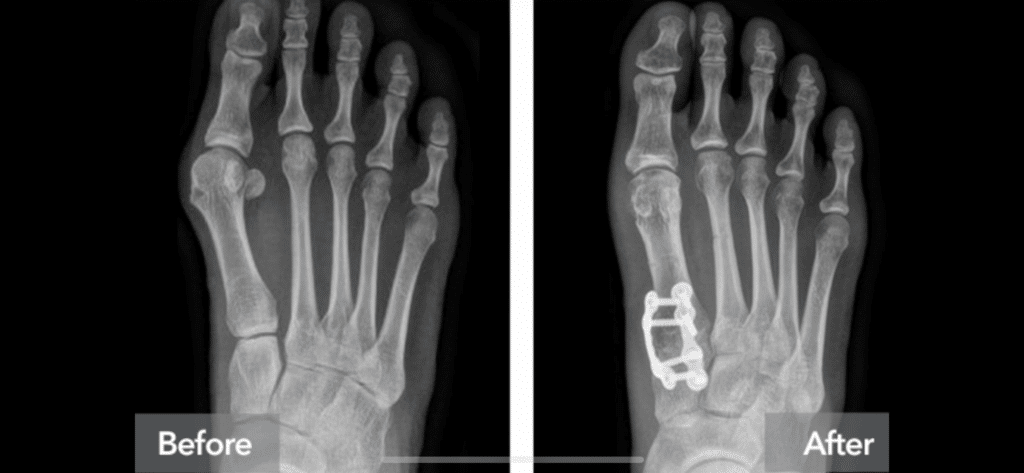Lapiplasty is a recent innovation allowing your podiatrists like Dr. Emmanuel Fuzaylov to treat the root cause of bunions. Since bunions are caused when your foot bones move out of place, correcting your bones’ placement can solve the problem. Typically, bunions are first treated with nonsurgical options. Switching to different shoes or using inserts can often help to relieve bunion pain. If these treatments prove ineffective, patients are offered a bunionectomy, in which bunions are surgically removed. Lapiplasty offers patients a promising solution.

WHAT DOES LAPIPLASTY TREAT?
Lapiplasty is used for bunion treatment. If you have a painful bunion that hasn’t responded to more conservative treatments, your podiatrist may suggest lapiplasty. The following signs might indicate that it’s time to consider this procedure:
- Your feet hurt while walking
- Comfortable shoes don’t help
- Your big toe is swollen and painful
- Medication, limiting activities, and other nonsurgical treatments haven’t helped
- Your big toe feels stiff and is hard to flex
- Your big toe has begun pointing towards your smaller toes more than usual
- You have generally good bone health
WHAT IS LAPIPLASTY BUNION TREATMENT?
Lapiplasty is referred to as a “3d bunion surgery”or 3d surgical procedure, because it helps to correct your foot bone placement in all three dimensions. The visible sign that you have a bunion is often a painful lump near your big toe. However, bunions are often caused by problems with the joint in your foot’s center. When this joint malfunctions, your metatarsal bone moves out of place. It pushes your big toe, causing the lump that you see. However, a lack of joint stability can also cause the metatarsal bone itself to be positioned incorrectly. The bone can shift upward and out of alignment, and the joint can also rotate to an angle that causes pain. While traditional bunionectomies can help relieve pain, many patients are experiencing better outcomes with lapiplasty. Some advantages include:
- Lapiplasty is a less invasive procedure than bunionectomy
- Lapiplasty offers more guidance during the surgical procedure, reducing the need for freehand cutting
- Patients may recover in 6-8 weeks after lapiplasty procedures
- On average, patients report less post-surgical pain after a lapiplasty
- Patients often experience fewer mobility issues during recovery from a lapiplasty
- Lapiplasty treats the cause of bunions, so it often reduces or eliminates any future need for surgery
Your lapiplasty will be performed in an outpatient setting, and it will take around an hour. It might take slightly less time, or slightly more if your doctor needs to perform additional procedures. You’ll receive a nerve block as well as general anesthesia, but you’ll still be able to go home that day.
During a lapiplasty, your surgeon uses advanced, recently patented tools. These help to minimize incision size and correct your alignment problems in all dimensions.
- The Positioner correctly aligns your foot bone before surgical cuts are made.
- The Cut Guide helps to produce precise cuts while your foot is held in the correct alignment, minimizing damage to your bones.
- The Compressor helps to manipulate your joint back to its proper position while preserving other surgical corrections made.
- Special Plating is inserted to provide stability, so you can quickly return to walking on your foot. These inserts can help fuse your unstable joint, relieving pain while preserving mobility.
These tools help to produce consistent, predictable results from one surgery to the next, reducing complications and variations among patient outcomes.
LAPIPLASTY RECOVERY
Recovery from lapiplasty is much easier than recovery from a bunionectomy. Traditional bunion surgery often involves:
- Extended recovery time that can last up to 6-8 weeks
- Limited mobility and the need for scooters or crutches
- Wearing a cast on your foot
- Several weeks of avoiding any weight bearing on your foot
However, when recovering from a lapiplasty, your life won’t be disrupted so dramatically. You can expect:
- Putting weight on your foot within a few days after surgery
- Walking with a boot for a few weeks
- Returning to normal, supportive shoes within about 1.5 to 2 months
- Return to normal activities within about 4 months
After your lapiplasty, it’s important to follow through with regular checkups so your surgeon can assess treatment outcomes. Follow your doctor’s advice, and don’t return to normal footwear or activities sooner than your team recommends. It’s also important to remember that even after surgery, it’s best to avoid shoes that cause discomfort.
IS LAPIPLASTY RIGHT FOR YOU?
If you’re ready to discuss the possibility of lapiplasty, call D.r Emmanuel Fuzaylov of Best Foot Doctor NY at (718) 291 9020 for an appointment at one of our six convenient locations. You can also schedule an appointment online using these links.
